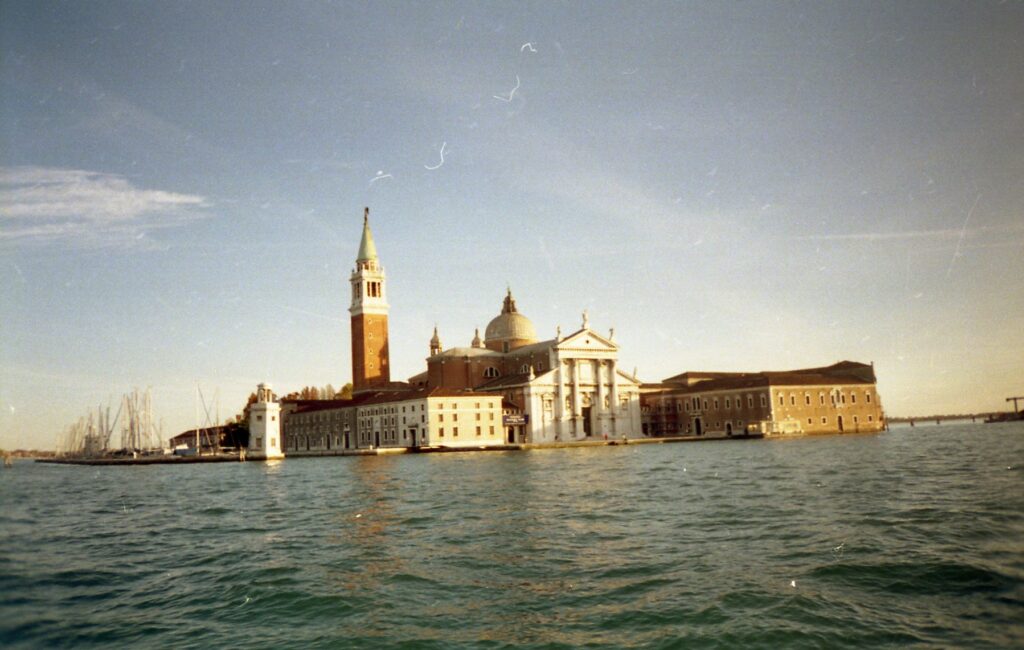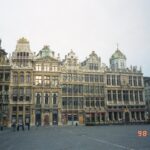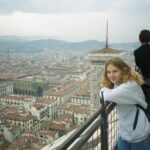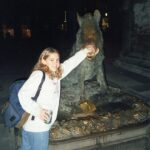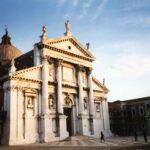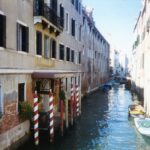
Florence and Venice
In the dark ages, pre-internet or early internet days, I couldn’t book trips or flights online and had to rely on travel agents, paper or the phone. I was told about a regional travel company by Debbie Schemmel, a new friend we had met on our previous trip to Bangkok, Singapore, and Hong Kong in 1997. Debbie had used the company for a trip to Europe and mailed me a flyer for this trip to Italy, recommending them.
It was a 6-night trip, three in Florence and three in Venice in early November. Alex was going to be missing a week of school but when I told Mrs. Hines, her 6th grade teacher, she was going to Italy, she was excited and just told us Alex could make up all homework with a report on her visit.
We left Saturday, November 7th, for O’Hare, arriving around 1400. Our flight was scheduled to leave at 1645. Alex took notes as we traveled for her report: “A week in Italy, from Firenze to Venezia“. She wanted to be very detailed, too, and wrote down information from the pilot such as “it will be over 4100 miles to Brussels and then another 582 to Florence (Firenze in Italian). We will be flying eight and ½ hours to Brussels and an hour and ½ to Florence.” I will include some of Alex’s comments in quotes.
Brussels
We arrived in Brussels around 0700 local time. After meeting our group and tour guide at a designated place in the airport we waited for the bus driver and a local guide to begin our tour of Brussels during our 5-hour layover. We saw the Atomium, a replica of an iron atom built for the 1958 World’s Fair. Belgium is a big iron and steel industry country. We visited the Chinese pavilion, also built for the World’s Fair.

Like the UK, Belgium is a constitutional monarchy with a parliament. “We drove by the Royal Palace which just looked like a big fancy house behind a tall fence, not really like a palace. It was built in the 1700’s, and Napoleon also lived there.”
Brussels looks like many other European cities I have visited. Cobblestone streets, lots of pedestrian-only city squares, and tall, very narrow houses. We learned they had a law similar to one in Georgetown, where they paid taxes based on the width of the house.
We parked and walked to the Grand Place, a very large square with several churches and guild houses. It was registered as a UNESCO heritage site in 1998. Very beautiful. On the way we passed the Mannekin Pis statue that my 11-year-old thought very funny.
Our guide gave us a tour of the area, telling us a little history, and we also walked through the first covered mall in Europe, Les Galeries Royales Saint-Hubert, built in 1847 in an Italian neo-Renaissance style. It has a beautiful glass ceiling. We returned to the Grand Place for some coffee. It was very cool and damp and we need to warm up a little. Alex and I had hot chocolate and they served it with some squares of Godiva on the saucer. Alex had already tried and liked dark chocolate but this was her first taste of Godiva. Several doors down, they had a small Godiva outlet and I bought Alex a large chocolate bar, but I did made her share a small piece.
After our coffee stop, we went back to the bus and returned to the airport for our flight to Florence. We had some great views of the Alps from the plane. I lived over here for almost 3 years, got to see Switzerland, Austria, southern Germany, and the Alps in all those countries, but never saw them from the air. Beautiful.
Florence
 An hour and a half later we “arrivato”. The weather was beautiful, sunny and over 60+ degrees. We meet our local guide Sandra, who escorted us to the Hotel Corona D’Italia on Via Nazionale. It was a very attractive place, with marble table tops and great tile in the bath.
An hour and a half later we “arrivato”. The weather was beautiful, sunny and over 60+ degrees. We meet our local guide Sandra, who escorted us to the Hotel Corona D’Italia on Via Nazionale. It was a very attractive place, with marble table tops and great tile in the bath.

We met for our walking tour of Florence soon after check-in. Sandra took us down the street to San Lorenzo, an old church with a plain brick front built by Brunelleschi in 1419. Alex and I returned later and saw the very ornate interior. All churches here are just made of brick and the marble facades are added later. Michelangelo designed one for this church, but it was never built. There is a picture of his design hanging in the church.
We also went to the Palazzo Medici, the Battistero, Campanile, Duomo, and the Bargello.
Santa Maria del Fiore, the Duomo, or Cathedral of Florence, is the third largest church in the world, after Saint Peter’s in Rome and Saint Paul’s in London. When it was completed in 1436 it was the largest. The dome is the largest brick dome ever constructed and was designed by Filippo Brunelleschi.

We also went to Santa Croce, another important gothic church built in 1294. Michelangelo, Machiavelli, and Galileo are all buried there.
We returned to the hotel and found a restaurant close by. Two of the ladies from our tour, Jean Williams and Shirley (I didn’t remember her last name when I wrote this up even 24 years ago) joined us. I had a huge calzone.
Monday, November 9th, after eating breakfast downstairs, we walked down the street to the Mercato Centrale. It is a very large market where the Florentines buy all their food, seafood, produce, meat, and dry goods. Our guide recommended we stop by and see what “real” life was like in Florence.
We returned to San Lorenzo, the church of the Medici and their burial place. We visited the two Medici Chapels or “Cappelle Medicee”, the New Sacristy, designed by Michelangelo and the Chapel of the Princes. They were added in the 16th and 17th centuries to Brunelleschi’s church.
After the church, we visited the Palazzo Medici, the seat of the Medici family from 1444 until 1540 when they moved to the Palazzo Vecchio. It is full of amazing art from Michelangelo, Donatello, and Botticelli. We paid to enter the Capella dei Magi, a tiny chapel upstairs with a beautiful fresco around the walls. We visited the courtyard and gardens.
We walked to the Duomo or the church of Santa Maria del Fiori. We had gone inside the previous night with Sandra, and she had given us a quick tour and talked about the painting in the dome, but I wanted a longer visit to climb the dome. The church dominates the skyline of Florence. It has an absolutely beautiful façade of pink, white, and green marble. It was built in the 13th century. The dome was finally completed in the 15th.

We climbed the 463 steps to the top of the dome. The steps between the walls come into the interior of the church at the bottom of the dome. Walking around the narrow balcony offered great views of the paintings of the dome. We were directed back in another door further along the balcony and continued our climb up around the double walls of the dome. Very narrow stairs circling around, we had to hug the walls when others were on the way up or down. The roof provides a breath-taking view of all of Florence.


When we returned to the piazza, Alex wanted to climb to the top of the Campanile, too, which is another 414 steps. The Campanile, or bell tower, was started in 1334 and completed in 1359. Like the cathedral, the tower is covered in marble and has many statues and bas-reliefs on the exterior on the facade.
We stopped for lunch in a pizzeria then walked down to the Arno River and then Palazzo Vecchio or Old Palace. The Medicis moved here in 1540. It was and still is the Town Hall. This is one of the two buildings in town that look like what Americans think of as “castles” with crenellation and towers. Palazzo Vecchio has been the “center of political life in Florence since the 14th century.”
 Before our visit, Alex asked to stop and feed the pigeons in Piazza Della Signoria. The piazza was the location of Savonarola’s ‘Bonfire of the Vanities’ in 1497. He was burned at the stake here in 1498. One side of the square is a covered area with sculptures. A copy of the David and also a Neptune sculpture are here. The original David was moved inside, to the Galleria dell’ Accademia, to prevent damage.
Before our visit, Alex asked to stop and feed the pigeons in Piazza Della Signoria. The piazza was the location of Savonarola’s ‘Bonfire of the Vanities’ in 1497. He was burned at the stake here in 1498. One side of the square is a covered area with sculptures. A copy of the David and also a Neptune sculpture are here. The original David was moved inside, to the Galleria dell’ Accademia, to prevent damage.
Inside the Palazzo Vecchio, we visited the Assembly room, the meeting place of the Florentine Republic Assembly. Michelangelo’s Vittoria (Victory) is displayed here. We went up to the Terrazza di Saturno, which is an open loggia, or porch, with views of the river and hills on the other side of the river. We also went into the Sala delle Carte or map room which has a large collection of globes and maps which show the world as it was known in 1563.
 We visited the Museo di Storia della Scienza, located in the 14th century Palazzo Castellani. It became the Museo Galileo in 2010, after a 2-year redesign and renovation. It is a museum of physics and natural sciences, with many scientific instruments from the Medici Collections and items of Galileo’s, two of his telescopes, many other scientific instruments, and also, bizarrely, his finger. I highly recommend this very interesting museum. I’d be happy to return to see more.
We visited the Museo di Storia della Scienza, located in the 14th century Palazzo Castellani. It became the Museo Galileo in 2010, after a 2-year redesign and renovation. It is a museum of physics and natural sciences, with many scientific instruments from the Medici Collections and items of Galileo’s, two of his telescopes, many other scientific instruments, and also, bizarrely, his finger. I highly recommend this very interesting museum. I’d be happy to return to see more.
We walked along the river, passing Mercato Nuevo and the brass boar, el Porcellino, and across the Ponte Vecchio, the Old Bridge. The bridge only has gold and jewelry stores on it by decree. It used to have butchers and other shops, but the Medici wanted it cleaned up. The Medici also built a private walkway on the top of the bridge when they moved from the Palazzo Vecchio to the Palazzo Pitti. They didn’t want to have to mingle with the common folk when they crossed the river to get back to their chapel.

Returning across the bridge to the hotel we stopped at the Battistero, or Baptistery. It is dedicated to John the Baptist, the patron saint of Florence. Constructed between the 5th – 7th centuries, everyone in Florence, including Dante, was baptized here. Both the floor and ceiling are covered in gorgeous mosaics. We had seen the “famous south bronze doors by Pisano” with the 10 panels from the life of John the Baptist yesterday. The east doors are divided into 10 panels showing scenes from the Old Testament.
We sat for a while enjoying the altar and the paintings showing the Last Judgement. We found another great little restaurant for dinner. We met a couple from Australia, Allen and Elise. They were on their honeymoon and traveling for 3 months. We had an enjoyable time talking with them.
Tuesday, November 10th, was our last full day in Florence. We walked back down the street towards San Lorenzo. Sunday and Monday, many of the museums, shops, and open markets were closed. Today they were setting up for the Mercato San Lorenzo. We were out a little early and the vendors weren’t set up, so we planned to stop on the way back to the hotel that evening, since it is open until 1900. We walked back to the river and across the Ponte Vecchio to the Palazzo Pitti.
It is very plain outside, like a federal office building you’d see in Washington D.C, but so beautiful and ornate on the inside. We bought tickets to the Museo delgi Argenti (Silver Museum), the Galleria Palantina, and the Royal apartments or Appartamenti Monumentali. The palace was built for Lucia Pitti in 1457, he wanted a better palace than the Medici. The Medici moved into it in 1550, and it remained the residence of the rulers of Florence.
We went to the silver museum first. All the rooms have gorgeous paintings on the walls and ceilings that almost distracted me from the exhibits. Obviously, there was lots of silver, but also glass, jewelry, and religious relics.
We went to the Galleria next and walked into the Salon, the most incredible room I’ve ever seen, at least until I saw the Public Audience Chamber next door. Probably 25 to 30 foot ceilings, and the murals on the walls, amazing! Words can’t describe them, so I won’t even try. Pictures weren’t allowed, unfortunately.
Alex’s comment, that shocked her teacher when she read the report, the palace was beautiful but it had “a bunch of boring, dark paintings”. She wasn’t wrong. Horrible to say that about paintings by Titian, Raphael, Van Dyck, but most were unrecognizable from hundreds of years of dirt and grime. We visited the royal apartments. Not as ornate as the Salon and Audience chamber, but the living room and bedrooms all had beautiful furnishings.
After the palace, we visited the Boboli gardens, created for the Medici when they moved into the Palazzo Pitti. There is an island, or isolotto, in a pond, lots of fountains, walkways, hedges, an amphitheater. It was very large. We would have liked to just walk around it some more, but it was already noon and there was more I wanted to see in the city. We left and walked back to the bridge. We found an excellent little sandwich shop before we crossed, so we got two huge sandwiches on focaccia bread and sat on the edge of the bridge eating our lunch and enjoyed the view.

We walked along the river to the Bargello, the city’s main law court, the headquarters for the police, and later used as a prison until 1865. After purchasing tickets, we walked through a large room with many sculptures by Donatello, Michelangelo, della Robbia, then a courtyard with huge arches on all four sides. There are many exhibits in the museum, including coins, paintings, and clothing.

After the Bargello, I had promised Alex we would stop at el Vivoli, a “legendary” gelateria. We had passed it Sunday night on our walk with Sandra, but didn’t have time to stop. I knew it was close to the Bargello, but I couldn’t remember which street so I asked the guard at the Bargello as we were leaving, “down the street, second right”. We found it with no problems and checked out the flavors. Alex ordered a medium size bowl of ciaocolotto, I got half chocolate and half caramel creme. Delicious. There are beautiful murals on the walls here. We ran into Shirley and Jean as we were leaving.


I was on a mission to see David next. So I dragged Alex to the Galleria dell’ Accademia. After the ticket desk, and rounding the corner, is the main hall. At the end with a large dome over it is Michelangelo’s David. The statue is huge, much larger than I expected. Also displayed in the hall are unfinished works by Michelangelo; I could see the people emerging from the stone and marble. The gallery is the “single most important collection of sculptures by Michelangelo” in the world.
We walked down to Piazza San Marco after leaving the gallery. San Marco church and convent is located on the plaza. We had browsed the church yesterday. The convent was closed but we didn’t go back, since Alex wanted to go shopping. We walked back to the San Lorenzo market and Alex bought the black and gray sweater she had seen earlier. We stopped in another pizzeria to split a pizza and had some more gelato. We returned to the hotel around 2100. We had to have our bags packed and outside the door early for the porters to pick up at 2130.
Venice
On Wednesday, November 11th, we were up early, had breakfast and were on the bus by 0830. We drove northwest through Tuscany, passed through Bologna, seeing the beautiful hills and villas of the region. Driving through the Dolomites it got very foggy. Alex had gotten on the bus early to claim the long back seat. She was able to lay down, sleeping most of the way, while I read my guidebook on Venice.
We arrived around noon, passing over the causeway from Mestre on the mainland. The road stops on the west side of the city, so we got off the bus and walked to the hotel.


A boat was coming for the luggage, so we grabbed our carry-on’s and followed our local guide to the Hotel Al Sole, located in a 15th c palace. Looking up the hotel for this post, it is still in existence and has undergone a complete restoration. But when we stayed, the rooms were very disappointing after our great hotel in Florence. The beds sagged, the bath was long and narrow with a four foot long tub, no shower.
We didn’t meet for our walking tour of Venice until 1500, so we went out to find lunch. Shirley and Jean joined us again, we walked down the street until we found a restaurant with tables out front. With the service charges, cover charges, it came to over L150,000. Expensive for a very average meal. Alex and I browsed the shops nearby and she found a little place where she saw Venetian glass rings. She bought one with a yellow and black flower.
At 1500, we met in front of the hotel. They had ordered two water taxis for our group to take us down to Piazza San Marco. We went from our narrow canal in front of the hotel to the “Canale Grande”. Breath-taking. It is as amazing as it looks in photos, but it was just incredible to be there. We docked a little east of the Palazzo Ducale, or Doge’s Palace.

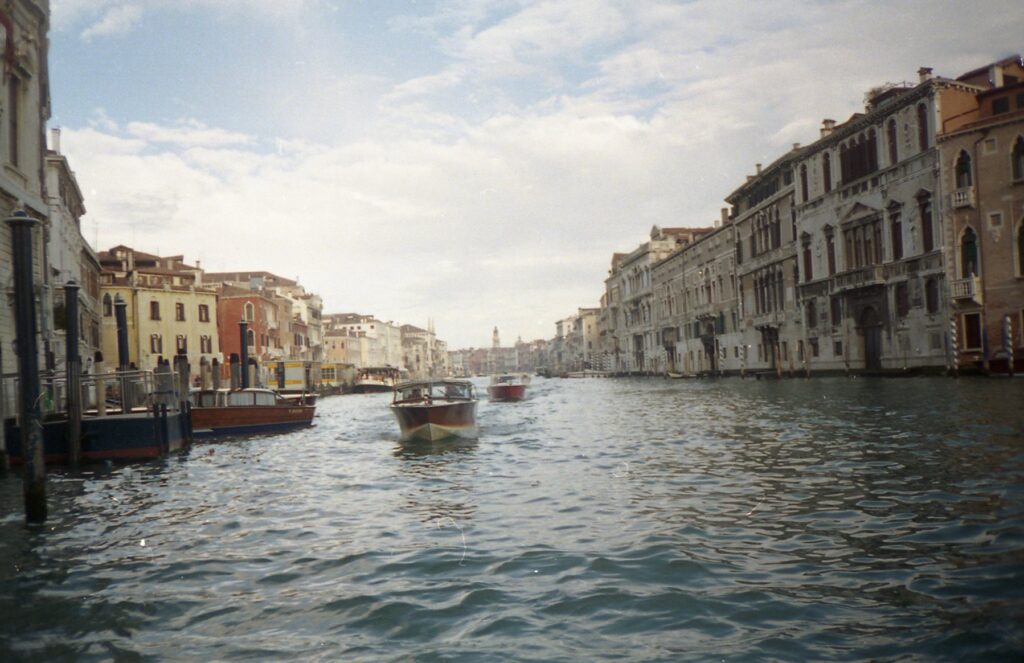
We met our local guide, then walked to the Palace passing the Ponte Sospiri, the Bridge of Sighs. The building itself is beautiful, very ornate, Byzantine architecture. Home to the offices of state for over 1000 years, the three wings of the current building are from the 14th and 15th centuries. We also saw the largest oil painting in the world Tintoretto’s “Paradiso” in the main hall and many other rooms.
We visited the Basilica di San Marco, begun in 832 to bury the body of St. Mark, which had been returned from Egypt in 829. A beautiful facade, with 4 bronze horses on the loggia (the originals were moved inside to protect them), but awe inspiring inside with a multitude of arches, gold mosaics on all the walls, and a very elaborate floor, which took 200 years to complete. The guide said the building still wasn’t done. We visited St. Mark’s grave and our guide told us more about the 1000 years of history of the building.

We wandered through Piazza San Marco and then went to the hotel. Shirley and Jean joined us again when we went in search of the vaporetti, or water bus, stands. We wanted to get a 3-day pass so we could travel the canals cheaply without having to buy tickets for every trip. We finally found it after going the wrong way from Piazza Roma. We bought our passes and went back down the Grand Canal. We also picked up tickets to a Vivaldi concert for tomorrow night at San Bartolomeo. We got off at the Rialto Bridge and walked through town, ending at Piazza San Marco. We took a water bus back to Piazza Roma and then walked back to our hotel.
The morning of Thursday, the 12th, was our tour of the three lagoon islands of Murano, Burano, and Torcello. We were scheduled to leave at 0900 but were kept waiting for about 30 minutes by the same four people who had been late all week. We finally made it to a dock on the Grand Canal where a charter boat was waiting for us, sailed down the Grand Canal, and turned north on the Canale di Cannaregio. We passed under the beautiful 3-arch bridge called “Ponte Tre Archi”.
Murano is is where all the glass factories were moved in 1291 to prevent fire in the main city. We watched a glass blower and then browsed through the shops. Venetian glass is very beautiful and very, very expensive. I saw a number of beautiful items I would have loved but we left the others to shop and walked up the canal sightseeing until time to return to the boat.

We visited Torcello. Believed to be the city’s birthplace, it was settled in the 5th century. Only 30 people currently live here. We went to the Cathedral of Santa Maria Assunte, Venice’s oldest building, built in 639.
Our guide gave us a tour of the church telling us about the art, altars and the 12th century mosaic of the Last Judgement on the back wall. We had time to wander down the canal behind the church for great views of the bell tower.
Our next stop was Burano. We walked down the main street, lined by very colorful houses, to a big square. Towering over the square is a leaning tower, behind the church of San Martino. Alex and I did some hasty shopping for lace, glass, and hats for gifts.
We left for Venice arriving back at Piazza Roma around 1330. After dropping off our purchases we caught a vaporetti to the Rialto Bridge. We did a little shopping and wandered down to Piazza San Marco again, then caught another water bus to San Giorgio Maggiore to go up the bell tower and see the view. Supposedly the best in Venice, even better than the bell tower of San Marco.
A monk operated the elevator to the top. There are no stairs so no climbing, and Alex was disappointed. We were there around 1630 and the sun was beginning to set. We could see all of Venice from here all the way out to the Lido, absolutely gorgeous. After enjoying the view from all sides of the tower, we went back down and caught the water bus back to Piazza San Marco.
Alex and I parted from Jean and Shirley who wanted to see the Guggenheim. We wanted to go back to the Basilica, which we were rushed through last night. We went up to the Museo Marciano. There are steps outside the church right before you enter the main doors that lead up and up.
The view when you get out is worth the climb and the money. We were standing at the back of the church looking down at the sanctuary. We saw a lot of great artwork, some of the gold mosaics up close (I got a picture!), and the original bronze horses all inside the museum. We found a door and went outside, it lead to the Loggia dei Cavalli; a big balcony at the front of the church looking out over the plaza. The loggia wraps part way around both sides of the church. We enjoyed the sunset immensely.
After the museum, we wandered through the church again stopping to look at more of the art, like the Pala d’Oro, an altar screen with 2600 pearls, rubies, and emeralds. We walked around the piazza waiting for Jean and Shirley. We were going to meet us at 1830 for dinner and then we were all going to the concert together at St. Bart’s. We sat and people watched, resting our feet, while waiting for them.
We found a very nice place to eat. Alex and I had pasta e’ fagoli and we split a great steak with a balsamic vinegar glaze. We saw an Italian lady who ordered the squid (cuttlefish) cooked in its own ink, so it was black. I would have loved just to try a bite, but there was no way I was going to get a whole order for around 75,000 Lire. We finished up our meal and hurried back to San Bartolomeo’s for the concert.
Alex was rather bored, but I enjoyed it very much. I’ve never really seen a classical concert except on PBS. They played Vivaldi’s Quattro Stagione, “Four Seasons”. They finished around 2230 and we went back to the hotel, catching a vaporetti at the Rialto.
Friday the 13th, was our last day on vacation. We walked down to Piazza Roma and caught a water bus to San Marco. We walked from there on down to the Arsenale (the old Navy arsenal). On the way, we stopped and found Alex’s Venetian mask she had been asking for and she fed some more pigeons in the square with rolls she took from breakfast. There was still much to see in Venice, but we took it easy, just enjoying the weather and wandering along the canals.

We finally made it to the Museo Storico Navale. Alex and I wandered through all four floors looking at all the old boats, the people-powered torpedo, uniforms, gondolas, lots of WWI and WWII boats and ships. We also walked on down to the second building, Padiglione delle Navi, where there is a collection of ancient gondolas, they are gorgeous. The entry ticket includes both buildings.
We walked back up to Piazza San Marco, stopping at an outdoor café along the way where Alex got a pizza and I got a sandwich. I had never tried it, so ordered tiramisu. Alex had a bite and wanted one of her own. When she got it, she didn’t like it. It tasted like coffee too much. I thought it was excellent even though I don’t drink coffee. We stayed for quite a while enjoying the view over the lagoon.
Back at Piazza San Marco, we decided to use the other half of the tickets from the Palazzo Ducale and visited the Museo Civico Correr. I could have stayed much longer, but we had plans in about two hours, regardless we did see beautiful rooms and exhibits. Alex liked the clothes the best, she was amazed by the 2-foot platform shoes, and wrote about them in her report.
By then it was getting towards late afternoon and we had planned to meet Jean Hall and Shirley for a gondola ride at 1630 so walked over to the Rialto Bridge. We waited until 1700, but they never came. We later learned they were waiting for us at the San Marco stop.

After waiting, I went ahead and paid for the gondola ride. L120,000! About $80. Our gondolier had the white and blue striped shirt and the straw hat like in the books. We went north under the Rialto Bridge then turned east into smaller, narrow canals. It was wonderful. He called out something like “oo – ee” when we were approaching corners to let others know we were approaching. He told us a lot about the houses on the canals too. We had about a 45-50 minutes trip, then went back to the Grand Canal.
We did some window shopping on the bridge. We found a great little shop and bought some wonderful focaccia bread sandwiches, sat and ate and watched the people go by. It was after 1900 when we went back to the hotel. I thought we better pack, since we had to get up at 0430 and catch our 0700 plane. I hate getting up early on vacation but it happens frequently.
We packed up and then stayed in the lobby for a little while talking to the others in our group. We put our luggage in the hall for pick-up, then went to bed.
We were downstairs by 0500 and we walked back to Piazza Roma where a bus was waiting to take us to the airport over in Mestre. It was a quick trip, 10 or 15 minutes. We had time to spend our last L30,000 on some chocolate and some sodas while we waited for the plane. A short 1 ½ hours later we were in Brussels, where we had close to a 4-hour layover. I used some euros for drinks, my first taste of local Stella beer, plus more Godiva for Alex. After an 8-hour flight to Chicago, a train to our car, and a 2-hour car trip, we were home at last. We stayed up until about 7:30-8 that night, to get back on local time.
** All photos property of Lisa, not to be copied or reproduced **
